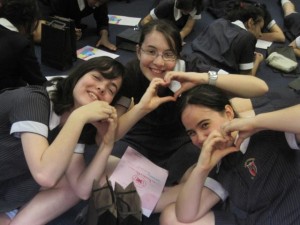There are a couple of important events coming up next week that I want to let you know about. Forget-me-knot Day is Friday 12th November, in support of survivors of child abuse. And from 12–13 November, some of the world’s leading experts are in Sydney for the ACARP conference on clergy abuse and a sexual assault summit run by Survivors Australia. I will be attending, so please come and say hi. I hope to see many teachers there, as sexual abuse is such an important issue for the girls we work with.



At least 12% of girls are sexually abused before the age of 15, according to the Australian Bureau of Statistics. That’s more than 1 in 10 of the girls in our classrooms. As sexual abuse often goes unreported, the real figure is probably even higher.
In my teaching career, sadly I was told of sexual abuse by four separate girls, and worked with them through the process of reporting it to DOCS and getting counselling for them. It is heartbreaking to see the impact of sexual abuse on girls. And reading the firsthand account of Nicole Wells, founder of Survivors Australia, it’s clear just how urgent it is that we do more to prevent it. She was 8 when she was first abused. Of the long-term effect, she writes:
This wasn’t just the destruction of my childhood . . . I couldn’t finish school. I couldn’t go on to university. I couldn’t keep friends. I couldn’t maintain relationships. I couldn’t keep a job. I couldn’t be happy. I couldn’t control my anger . . .
Comparatively speaking I’m one of the lucky ones. I’m alive. I’m talking about my trauma. I am finding the strength to help myself and help others. Many don’t survive and are consumed by substance and other forms of abuse and/or suicide. Most never reveal what has happened to them.
In the midst of my anger and sadness at the injustice of sexual abuse, I remind myself of girls’ incredible strength and resilience. With professional support and love, long-term emotional wounds can begin to heal. Melinda Hutchings, author and ambassador for Forget-me-knot Day, says:
My message as a survivor is that to overcome the trauma of sexual abuse it is important to be open and honest about it, and not to be afraid to seek professional help. The process of seeking professional help can be painful because it will bring up memories and horrible feelings will rise to the surface – however, the only way out is through, and by acknowledging the pain and finding strategies to deal with it, you really can move forward and create a happy and fulfilling life . . .
For those who love victims of child sexual abuse, listening, understanding and supporting are critical to the healing process.
Melinda’s latest book, Things Will Get Better: Finding your way through teen issues, has a section about coping with sexual abuse, including real stories from teens along with expert advice.
BUSTING MYTHS ABOUT CHILD SEXUAL ABUSE
Stranger danger. We are right to teach our children to be cautious of strangers, but we also need to know that a child is more likely to be sexually abused by someone they know. “Most abuse occurs in the circles we mix within – the perpetrator is almost always someone known to the family,” says Melinda Hutchings. Most abusers are heterosexual males and they come from all socioeconomic backgrounds. Some are female.
It must not have been that bad if it took years for her to speak out about it. A girl may block sexual abuse from her memory or go into denial as a survival mechanism. Most girls are scared to talk, because abusers are often physically or emotionally violent and threaten to harm them or their loved ones. Other reasons a girl may keep abuse to herself is that she didn’t feel she had someone to talk to she could trust, she thought no one would believe her, she thought she’d get taken from home or she blamed herself for the abuse.
Children lie about sexual abuse. It is in fact rare for a child to make up a story about sexual abuse or imagine it.
WHAT CAN WE DO?
Watch for early warning signs. When a child has been sexually abused you are more likely to notice behavioural changes than physical signs. Here is a list of warning signs to watch for:
- An increase in aggression
- Going back to behaviour from an earlier developmental stage, such as bedwetting or thumb sucking
- Sexual behaviour and play that is too mature for her age
- Depression or withdrawing from friends and family
- Getting into trouble at school, especially if it seems in order to avoid going home
- Self-harm such as cutting or attempting suicide.
If a child’s disposition alters it is worth finding out why . . . By staying in tune with what is going on in your child’s world, you will have every chance of recognising if something doesn’t feel right.—Melinda Hutchings.
Never blame the victim. On this blog I’ve talked about the vitriolic language that is often used to deride a girl or woman who speaks out about sexual assault. The media, and indeed ordinary people, say things like “She was asking for it being dressed that way” or “Well, she went back to the footy player’s room, so what did she expect?” What message does that send to a 12-year-old girl who has to go home every night to an abusive situation? If she hears people making such judgments, how comfortable is she going to be about speaking up?
Be vigilant. We need to be mindful of the people in our children’s lives. Australian organisation Child Wise has some great resources on signs that should ring alarm bells, and how to create and choose organisations and activities that are safe for children.
Instinct is powerful so trust your gut when it comes to the people you invite into your life because they will automatically be in your child’s life as well.—Melinda Hutchings.
Educate. From an early age, every girl needs to be taught that no one has the right to touch her inappropriately or to ask her to touch them. Children also need to be taught that if an adult makes them feel scared or uncomfortable, they need to tell someone immediately.
Child sex offenders generally do not target children who are confident, knowledgeable and assertive when it comes to protecting their bodies.—‘Wise Up’ to Sexual Abuse, Child Wise
Listen. Reassure her that it is not her fault and that you believe her. Stay calm.
RESOURCES
Australia
Kids Helpline (24 hours) 1800 55 1800
Lifeline (24 hours) 131 114
Australian Childhood Foundation
Child Wise
Survivors Australia
ASCA (Adult Survivors of Child Abuse)
New Zealand
The Sexual Abuse Centre 0-3-364 7324
A note about boys: As this blog focuses on girls’ issues, in this post I have referred only to girls — but of course all children, boys and girls, are affected by sexual abuse, and all children need our protection and support.



